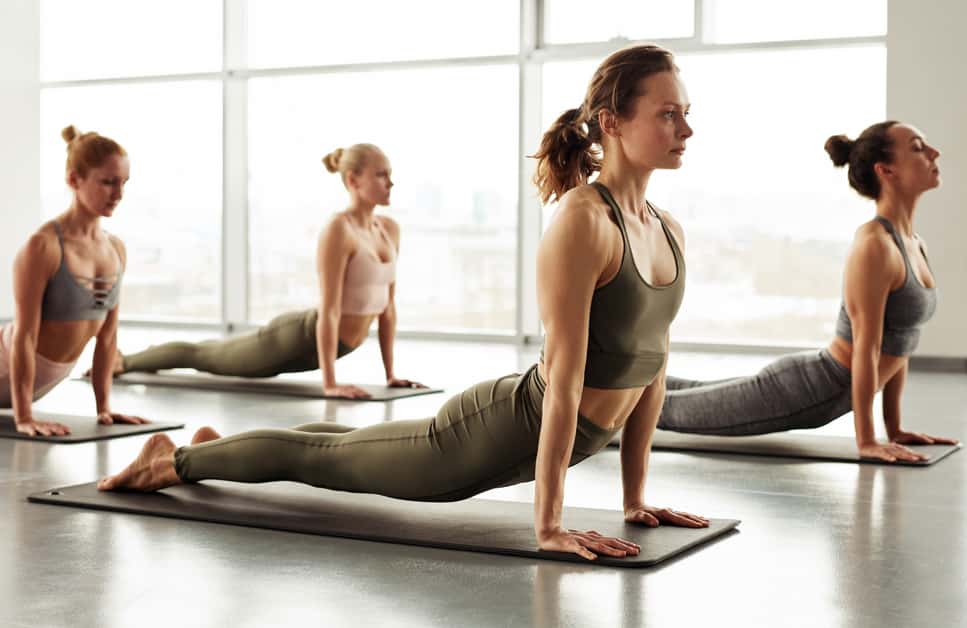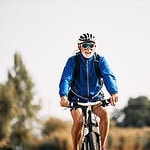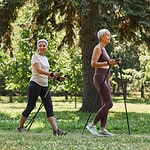Introduction
Yoga can be great for injury prevention and healing of a knee with a meniscus tear. The meniscus are two C-shaped pieces of cartilage that sit between the thighbone and shinbone. Tears usually happen with sudden movements, like during sports.
To help stretch and strengthen muscles around the knee joint, here are some poses to try. Be careful and stop if it hurts. Get help from a professional or someone knowledgeable to do the poses safely with your injury.
What is a Meniscus Tear?
A meniscus tear is an injury to the cartilage in your knee. It’s a common knee injury for athletes, but anyone can get it. Symptoms might be pain, tenderness, swelling and difficulty moving.
Rest and physical therapy are often the best way to recover. Yoga is great for rehab too. It helps with flexibility and strength. These poses are helpful for those with a meniscus tear:
- Chair Pose
- Downward Dog Pose
- Tree Pose
- Warrior I Pose
- Child’s Pose
- Half Moon Pose
Benefits of Yoga for Meniscus Tears
Yoga can be a good, low-impact option for recovering from a meniscus tear. Certain poses can give you strength, flexibility, and prevent further injury.
Yoga poses help you move your knees more and reduce inflammation. They also target different parts of the knee like the patellofemoral joint and quadriceps muscles. Doing poses like Downward Dog and Cobra can make these muscles stronger and give your knee more range of motion.
Asanas will also help loosen your hips, which can help balance your body. If your muscles are too tight or weak, they can put extra strain on your knees.
Lastly, yoga is calming and energizing. Doing poses like Sun Salutations helps you combine breathing and movement. This will help you focus and become stronger. It can also heal your meniscus tear or stop other injuries in the future!
Yoga Poses for Meniscus Tears
Yoga is the perfect way to rehab after a meniscal tear. It will help you heal! Different poses can help you rebuild strength, flexibility, and balance. These are key for recovery!
This article will show you some great yoga poses for rehabilitation:
Cat-Cow Pose
Cat-Cow Pose (Marjaryasana-Bitilasana) is a corrective movement used in Iyengar Yoga. This pose strengthens and stretches the lumbar spine and hips. It can help with meniscus tears, reducing joint irritation and increasing hip flexibility.
To do this pose, start on all fours. Position your hands beneath your shoulders and flex your feet back. Inhale, arch your back like an open book and let your belly sink towards the floor. This engages the pelvic muscles and stretches the lower back. On an exhale, draw your chin towards your chest and curve your vertebrae inward. Keep your elbows firmly rooted on the ground.
- Repeat 4-6 breaths.
- Rest in between sets.
- Beginners should do 6 more repetitions or transition into other poses.
Triangle Pose
Trikonasana, or triangle pose, is helpful for strengthening and rehabilitating weakened knees, especially meniscus tears. This standing pose strengthens the lower body and aligns the knee joints.
To do the pose, stand with legs 3-4 ft apart. Turn your left foot slightly inward, toes parallel with front hand. Back foot should be straight, toes pointing to side wall. From the hips, lean your torso over your left leg. Lower both arms horizontally along the floor for balance. Keep feet firmly grounded, reach right arm up to ceiling, press down through hip joint. Support from wall or chair is OK. Take 5 breaths before returning to neutral position. Do the same on other side.
Triangle pose gives stability and strength to the kneecap, rehabbing meniscus tears as well as other knee issues. Regular practice also improves posture and strengthens core muscles around vulnerable joints like the knees. This leads to better balance and stability for more strenuous activities over time like sports, climbing, and running.
Half-Moon Pose
Half-Moon Pose, or Ardha Chandrasana, is an amazing yoga posture for recovery after meniscus tears or surgery. It opens the hips, groin, and lower back, releasing tension and helping with rehabilitation. It may also help to improve knee mobility, which is helpful for those with meniscus tears.
To do Half-Moon Pose, begin in Mountain Pose with arms raised above your head, palms facing forward. Step your left foot back one foot from the right and make sure both hips face forward or diagonally forward. Bend the left knee so that your thigh bone is parallel to the floor. Rotate your right hip forward, opening it to the front of the room.
Exhale as you hold onto your inner right ankle with both hands. You can hold it at calf or ankle level, depending on your flexibility. Push against your ankle as if you were opening a door away from your body. Keep your torso long throughout the exercise to keep proper spine alignment and downward hip opening. Hold the pose for 30 seconds before switching sides or coming out of the pose. If it’s too intense, you can rest for a few breaths in Neutral Child’s Pose.
Half-Moon Pose is strong on the inner thigh and gluteal muscles, so go slow to avoid aggravation.
Downward-Facing Dog
Downward-Facing Dog, aka Adho Mukha Svanasana, is a very popular yoga pose. It stretches the spine and strengthens the body, improving posture, easing back pain and boosting circulation. Many people use it to relieve the pain from a meniscus tear.
To start, get into tabletop position on the floor. Place your hands and feet hip-width apart, with wrists under shoulders and knees under hips. Press firmly into all fours then lift knees off the ground into a V-position with toes facing behind you (like an upside down V).
Engage your core by drawing it towards your spine. Push strongly through pelvis and arms, evenly splitting energy between each hand & foot. Reach back through heels, pressing down onto the ground. Keep both legs strong by pushing against the weight from each arm. Arch the back a bit to stretch any tight areas along your spine. Avoid compressing the lower back. Engage smaller muscles!
Modify as needed based on range of motion in knee joint(s). Combine efforts of reaching forward with chest applied backwards onto thighs, while keeping balance in torso and not collapsing pelvis or pressing knees too harshly. Find the movement that works for your body!
Hold Downward Facing Dog for 30 seconds or longer. Try slow swaying motions. Then rest in Child’s Pose.
Warrior I Pose
The Warrior I Pose (Virabhadrasana I) is great for those with meniscus tears. It helps lengthen the knee joint’s tissues and boost flexibility and mobility.
To start, stand with your feet together. Then take a big step backward with one foot. Bend your front knee slightly until you feel a stretch in your hip flexor or lower back. Keep your front heel aligned with your knee. Don’t let your arch collapse inward.
Inhale, and bring both arms above your head. Gradually draw them back, keeping them parallel to each other. Extend them to the edges of your mat. Keep your spine straight. Look up at your thumbs with a long neck. Hold this pose for several breaths. Notice how it affects any soreness or tension around the meniscus tear area. When you come out of the pose, switch legs.
Doing Warrior I regularly will improve range of motion, strength and stability in the knee joint. Be aware of movements that could aggravate the injury if done incorrectly or too often.
Warrior II Pose
Warrior II Pose (Virabhadrasana II) is a gentle, supportive standing pose. It can help rehabilitate and heal meniscus tears. The pose is good for all levels. But, you should take care when entering and leaving the pose to prevent injury or pain.
To practice Warrior II Pose, stand with feet 3-4 feet apart. Your heels should line up. Turn your right foot inward at 90 degrees and left foot outward at 30-45 degrees. Bend both knees. Make sure the knee over the ankle is tracking straight ahead. Both legs should have a similar bend. However, the back leg won’t go as deep as the front leg.
Lift arms from the sides at shoulder level. Palms face down. Look away from the center for balance. Relax. Stay for 5 breaths. Then switch sides. Exhale as you lower arms. When changing sides, or coming out of the pose take it slow. This will provide extra protection and aid recovery in areas prone to tension, like around a meniscus tear.
Reclined Pigeon Pose
Reclined Pigeon Pose (supta kapotasana) is an ideal pose for those who have had a meniscus tear. It helps ease pain and stiffness in the hip joint and lower back.
Start by lying on your back. Bend one knee and cradle it with the opposite arm. Hold the foot and ankle of that leg with the same arm. Pull the raised leg closer to your chest until it’s resting alongside the other side of your body. Keep your hips level to the floor. You can also bend both ankles and cross them if it’s comfortable.
Gently extend and rotate the injured knee outward. Keep your hips neutral on the floor. To increase the stretch, you can use one arm to press on top of the knee or just underneath. For extra comfort, place a bolster or cushion under the knee. Stay in Reclined Pigeon for 3 minutes before releasing slowly. After, spend a moment in corpse pose (savasana). Repeat on the other side if desired.
Seated Spinal Twist
Seated Spinal Twist is great for meniscus tears. It relieves pain and stiffness in the knee joint. It also improves mobility and flexibility.
To do this pose:
- Sit on the floor. Extend your legs. Place the right foot outside the left thigh. Bend the left leg. Put the left foot inside the right thigh. This makes a 4 shape.
- Press into your palms. Lift through the waist. Lengthen the spine. Twist side to side. Deepen the twist. Feel a slight stretch in both legs. Especially near the right knee. Hold 15-30 seconds. Then, gently come out. Keep pressure off the joint. Switch sides. Repeat on the other arm with same leg positioning.
This pose can help with pain relief. It improves strength and function in weakened joints. It increases mobility and supports proper alignment. This helps with recovery after injury.
Child’s Pose
Child’s Pose is a calming and nurturing yoga position. It stretches the groin, hips and lower back, reduces stress and rejuvenates the body. It’s especially helpful for meniscus tears, as it strengthens surrounding muscles, aiding the healing process.
To do Child’s Pose, start with bent knees, feet tucked under and arms extended on either side. Lower your bum to the ground, with tummy resting on thighs. Forehead should be on the ground and hands lightly placed beside you or clasped behind.
Don’t over-stretch. Focus on long, slow deep breaths and press each foot evenly into the floor or mat. Stay in this position up to five minutes or until you don’t feel any pain but sense a slight pull around the knee joint.
Child’s Pose helps injury recovery and is great for relaxation and inner contemplation. Take time each day for self-care – it keeps joints healthy and happy!
Tips for Safely Practicing Yoga
If you have a tear in your meniscus and want to do yoga, here are some tips:
- Breathe deeply. This relaxes your body and reduces stress on your joints. It also helps reduce inflammation and heal tissue.
- Use modifications. Blocks and cushions can make poses easier.
- Don’t push too far. You should not feel pain in a pose. If you do, ease off and modify it. Move slowly.
- Be aware of your body. Put your hands where you need extra attention. This can speed up rehabilitation and reduce the risk of re-injury.
- Warm up before stretching. Do light aerobic activities like walking. This can help prevent muscle tears and stiffness. It also releases lactic acid build-up.
Conclusion
Yoga is a great way to help heal meniscus tears, both acute and chronic, as well as aid in the recovery from surgery.
Stretching, strengthening, and moving the hip flexors and quadriceps, along with focused core work, can help balance the hips. This can prevent meniscus tears, as well as improve healing time.
The poses mentioned are a good way to start a rehabilitative yoga practice for meniscus tears. Before beginning any type of exercise or adjusting poses, it is important to talk to your doctor.
With regular practice, kindness, and proper alignment, healing can take place through quality movement.
Frequently Asked Questions
Q: What type of yoga poses are best for meniscus tears and rehabilitation?
A: The best yoga poses for meniscus tears and rehabilitation are supine poses, standing poses, and seated poses. Gentle stretching, strengthening, and balance poses are also beneficial.
Q: Are there any poses I should avoid?
A: Certain poses and exercises should be avoided during recovery from meniscus tears and rehabilitation. These include deep squats, deep lunges, deep twists, and any poses that involve the full weight of the body on the knee.
Q: How often should I practice yoga to help with my meniscus tear?
A: It is recommended to practice yoga 3-4 times a week in order to help with healing a meniscus tear. It is important to listen to your body and do what feels comfortable and healing.





